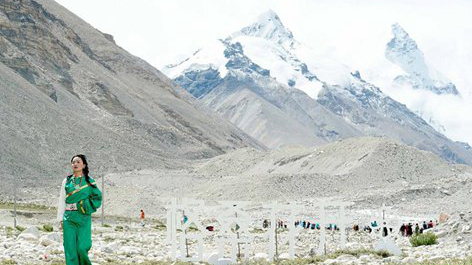
Editor's note: Hamzah Rifaat Hussain is a former visiting fellow at the Stimson Center in Washington and currently serves as assistant researcher at the Islamabad Policy Research Institute (IPRI) in Pakistan. The article reflects the author's opinions and not necessarily the views of CGTN.
On December 8, both China and Nepal agreed upon the exact height of the famed Mount Qomolangma, or the Mount Qomolangma, which is by a distance, the tallest peak in the world. This understanding between the two neighbors settled prolonged disagreements over the exact length of a peak, which has its summit point run across the Chinese-Nepalese border.
The bilateral relationship has gained from strength to strength and underlines how disagreements over key subjects can be resolved amicably and will not translate into heightened tensions, escalations, or threats.
In South Asia, alongside Pakistan and Sri Lanka, Nepal also features prominently in China's trade and connectivity initiatives, with positive optics and warmth characterizing this historically close relationship.
It thus came as no surprise when Nepali Foreign Minister Pradeep Kumar Gyawali considered Mount Qomolangma to be a "symbol of … friendship between Nepal and China" while announcing the findings of their surveys on a video call with his Chinese counterpart Wang Yi.
The Federal Democratic Republic had previously estimated that the height of the summit would be 8,848 meters or 29,028 feet as per the Survey in India back in 1954, which includes the presence of snow. After several adjustments, last spring, Chinese surveyors, amid the pandemic when the mountain was closed for expeditions for other climbers, came up with the correct estimates, which have been agreed upon this winter.
This smooth flow of events demonstrates how regular communications, goodwill, and joint statements affirming agreements between two close states can be achieved with little hassle.
The Nepal-China border – home to the famed peak, has never witnessed a border dispute between the two countries. This is largely due to the signing of the China-Nepal border agreement treaty in 1960 and ratification in 1961. The signing of the agreement also made Nepal the first country in the region to both agree to and ratify a border agreement with China.
As a result, all lingering border disputes were resolved between the two countries, which stand in stark contrast to China's disputes with India, which have resulted in skirmishes and escalations between the two. Kathmandu has consistently strove towards balancing the competing influences of its neighbors since the accession of the Kingdom of Sikkim into India in 1975, despite China currently being the largest source of foreign direct investment in the country.

Chinese mountaineering guides work on a route to the summit of Mount Qomolangma, May 26, 2020. /Xinhua
Chinese mountaineering guides work on a route to the summit of Mount Qomolangma, May 26, 2020. /Xinhua
The commitment towards non-alignment as part of Nepalese foreign policy has ensured that relations with China have not been jeopardized despite the volatile nature of the region.
The bedrock of the recent understanding reached on Mount Qomolangma and the strength of the bilateral relationship also rest with the Sino-Nepal Treaty of Peace and Friendship of 1960 – a settlement reached between both countries, heralding an era of close cooperation.
The essence of the treaty is also beyond historical symbolism, given that many Nepalese and Chinese journalists and military personnel have stressed how the Friendship Treaty of 1960 enabled a history of successful cooperation between the two countries. Examples include Kathmandu's agreement to join the Belt and Road Initiative in 2017, due to the foundation and principles laid out in the treaty of 1960.
On the subject of culture, Mount Qomolangma acts as a unifying force for both sides, given its mass appeal, touristic relevance, and stature as the highest peak in the world. The settling of differences regarding its exact length also questions the frequent criticisms emanating from Western capitals that China seeks to intimidate its neighbors over disputes which range in scope and intensity and eventually result in confrontations.
All disagreements with countries such as Nepal have been handled amicably through dialogue and understanding by Beijing with mutual recognition of the importance of non-interference and respect for state sovereignty. There is also no evidence to suggest that Nepal's close relationship with China has been a zero-sum game or at the expense of Kathmandu's ties with other regional powers such as India or with great powers such as the U.S. and the UK.
Binaries have well and truly been avoided, despite the massive disparity existing between both countries regarding economic development. Noted absence of skepticism over Chinese investments in Nepal and its contribution towards sovereign debt also challenges assertions regarding China's relationship with developing countries as being transactional.
The global significance of Mount Qomolangma will always remain intact, and the manner in which both Beijing and Kathmandu have developed understandings over its length and other subjects act as an example for other nations to follow.
(If you want to contribute and have specific expertise, please contact us at opinions@cgtn.com.)

